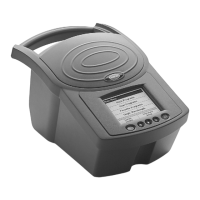Chemical Analysis
Chemical Analysis
5940022ChemAnal.fm Page 41
3.3 Interferences
Interferences are contaminants in a sample that are capable of causing changes in
color development, turbidity, or unusual colors and odors, thereby creating
errors in your results. A list of common interferences is included in each
procedure. Hach reagents are formulated to eliminate many interferences; you
can remove others by pretreating the sample as instructed in the procedure.
Test strips are available for many of the common interferences. These can be
conveniently used to screen samples for the presence of interferences.
If you get test results that you feel are inaccurate, if you get an unexpected color,
or if you notice an unusual odor or turbidity, repeat the test on a sample diluted
with deionized water. (See Section 2.7 Sample Dilution.) Correct the results for the
dilution, and compare them with those from your original test. If they differ
significantly, make a second dilution and check it against the first. Repeat the
dilutions until you get the same result (after volume corrections) twice in
succession.
For more information on interferences, see Section 3.2.2 Standard Additions. The
APHA Standard Methods book, an excellent reference for the water analyst, also
covers interferences in its “General Introduction.”
pH Interference
Chemical reactions are often pH dependent. Hach reagents contain buffers to
adjust the pH of the sample to the correct range. However, the reagent buffer
may not be strong enough for samples that are highly buffered or have an
extreme pH.
The Sampling and Storage section of each procedure gives the pH range for that
test. The DR/2400 Spectrophotometer can accept a Platinum Series pH electrode
for taking measurements through the instrument.
Before testing, adjust the sample to the proper pH as instructed in the procedure,
or by following these steps:
1. Measure the pH of your analyzed sample with a pH meter. Use pH paper
when testing for chloride, potassium, or silver.
2. Prepare a reagent blank using deionized water as the sample. Add all
reagents called for in the procedure. Timer sequences, etc., may be ignored.
Mix well.
3. Measure the pH of the reagent blank with a pH meter.
4. Compare the pH values of your analyzed sample with the reagent blank.
5. If there is little difference in the values of your analyzed sample and the
reagent blank, then pH interference is not the problem. Follow the Accuracy
Check for the specific procedure to more clearly identify the problem.
6. If there is a large difference between the value of your analyzed sample and
the reagent blank, adjust the sample pH to the value of the reagent blank.
Adjust the sample pH to this same pH for all future samples before analysis.
Use the appropriate acid, usually nitric acid, to lower the pH. Use the
appropriate base, usually sodium hydroxide, to raise the pH. Adjust the final
result for any dilution caused by adding acid or base; see Correcting for Volume
Additions.
7. Analyze the sample as before.

